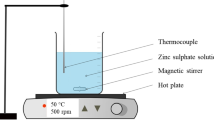Abstract
To discriminate between the relative weights of each factor involved in the global process of an electrokinetic treatment for remediation, mortar and brick contaminated with Cs, Sr, Co, Cd and Cu were submitted to electrokinetic treatments with different enhancing electrolytes (distilled water, Na2-EDTA, oxalic acid and citric acid), and the efficiency was analysed in function of the parameters involved in the process. The data obtained in this research, a matrix including 40 cases, have been correlated for the decontamination percentage in function of the key variables of the treatment, and the best correlation found, able to explain a variance of the 78.5% of the data, was a non linear exponential grow regression. An order in the weight of the contributions has been established that, from bigger to smaller contribution, is: constants of chelation equilibriums > precipitation as hydroxide constants > zeta potential > conductivity of the catholyte > pH catholyte > diffusion coefficient > pH of the material.








Similar content being viewed by others
References
Morillon C, Pilot G (1989) Decontamination of concrete by surface melting with a novel plasma-jet burner. Feasibility study. Comm. Eur. Communities [Rep.] EUR (1989) (EUR 12489)
Cornelissen HAW, Van Hulst LPDM (1990) Volume reduction of contaminated concrete by separation. I: Separation heating. Kema Sci Tech Rep 8:345–358
Cornelissen HAW, Van Hulst LPDM (1990) Volume reduction of contaminated concrete by separation. II: The role of concrete and process parameters. Kema Sci Tech Rep 8:359–366
Krause TR, Helt JE (1993) Applications of microwave radiation in environmental technologies. Ceram Trans 36:53–59
Hamilton MA, Rogers RD, Nelson LO, Holmes RG, Milner TN (1998) Biodecontamination: cost-benefit analysis of novel approach for decontamination of massive concrete structures. In: ImechE Conference Transactions (Nuclear Decommissioning ‘98), pp 123–130
Bostick WD, Bush SA, Marsh GC, Henderson HM, Box WD, Morgan IL (1993) Electroosmotic decontamination of Concrete. ORNL, Tennessee. Report under DOE contract DE-AC05-84OR21400
Sugimoto J, Soda A, Yoshizaki Y (1995) Development of decontamination and volume reduction technologies for radioactive concrete. Basic experiments on electrochemical decontamination and volume reduction by separating aggregate. I. Dekomisshoningu Giho 13:13–21
DePaoli DW, Harris MT, Morgan IL, Ally MR (1997) Investigation of electrokinetic decontamination of concrete. Sep Sci Technol 32:387–404
Castellote M, Andrade C, Alonso C (2002) Nondestructive decontamination of mortar and concrete by electro-kinetic methods: application to the extraction of radioactive heavy metals. Environ Sci Technol 36:2256–2261
Popov K, Glazkova I, Myagkov S, Petrov A (2006) Removal of Cesium from porous surface via the electrokinetic method in the presence of a chelating agent. Russ Colloid J 68:743–748
Popov K, Glazkova I, Myagkov S, Petrov A, Sedykh E, Bannykh L, Yachmenev V (2007) Zeta-potential of concrete in presence of chelating agents. Colloids Surf A 299:198–202
Popov K, Glazkova I, Yachmenev V, Nikolayev A (2008) Electrokinetic remediation of concrete: effect of chelating agents. Environ Pollut 153:22–28
Bard AJ, Faulkner LR (1980) Electrochemical methods. Fundamentals and applications. Wiley, New York
Newman JS (1991) Electrochemical systems. Prentice Hall, Englewood Cliffs
Hunter RJ (1981) Zeta potential in colloid science. Principles and applications. Academic Press Limited, New York
ASTM C 1202-97 (1997) Standard test method for electrical indication of concrete’s ability to resist chloride ion penetration. ASTM International, West Conshohocken
Castellote M, Andrade C, Alonso C (1999) Characterization of transport of caesium, strontium, cobalt and iron ions through concrete by steady-state migration and natural diffusion Tests. Adv Cem Res 11(4):161–168
Andrade C (1993) Calculation of chloride diffusion coefficients in concrete from ionic migration measurements. Cem Concr Res 23(3):724–742
Castellote M, Llorente I, Andrade C (2006) Influence of the composition of the binder and the carbonation on the zeta potential values of hardened cementitious materials. Cem Concr Res 36:1915–1921
Castellote M, Botija S, Andrade C (2010) Assessment of electrophoresis and electroosmosis in construction materials: effect of enhancing electrolytes and heavy metals contamination. J Appl Electrochem 40:1195–1208. doi:10.1007/s10800-010-0087-9
Burriel F, Lucena F, Arribas S, Hernández J (1952) Química analítica cualitativa, Publicaciones Madrid, Editorial Paraninfo, Madrid. ISBN, 978-84-9732-140-2
Acknowledgments
The authors thank the funding provided by the Spanish MMA through the project no. 055/2004/3 and the Spanish MINCYT and the CSIC for the funds provided through the CONSOLIDER-SEDUREC project.
Author information
Authors and Affiliations
Corresponding author
Rights and permissions
About this article
Cite this article
Castellote, M., Botija, S. Electrokinetic decontamination of heavy metals in construction materials: contribution of the different parameters to the global efficiency. J Appl Electrochem 41, 695–703 (2011). https://doi.org/10.1007/s10800-011-0282-3
Received:
Accepted:
Published:
Issue Date:
DOI: https://doi.org/10.1007/s10800-011-0282-3




